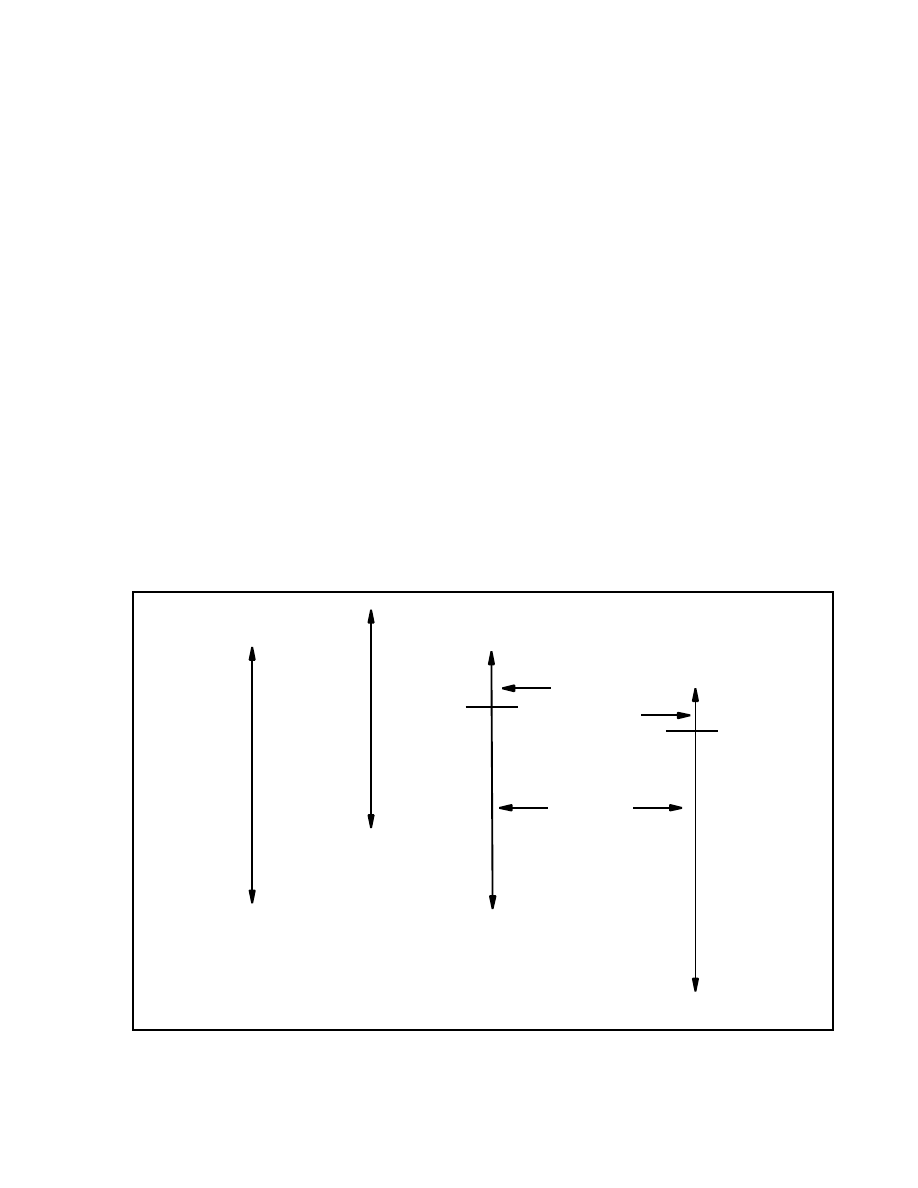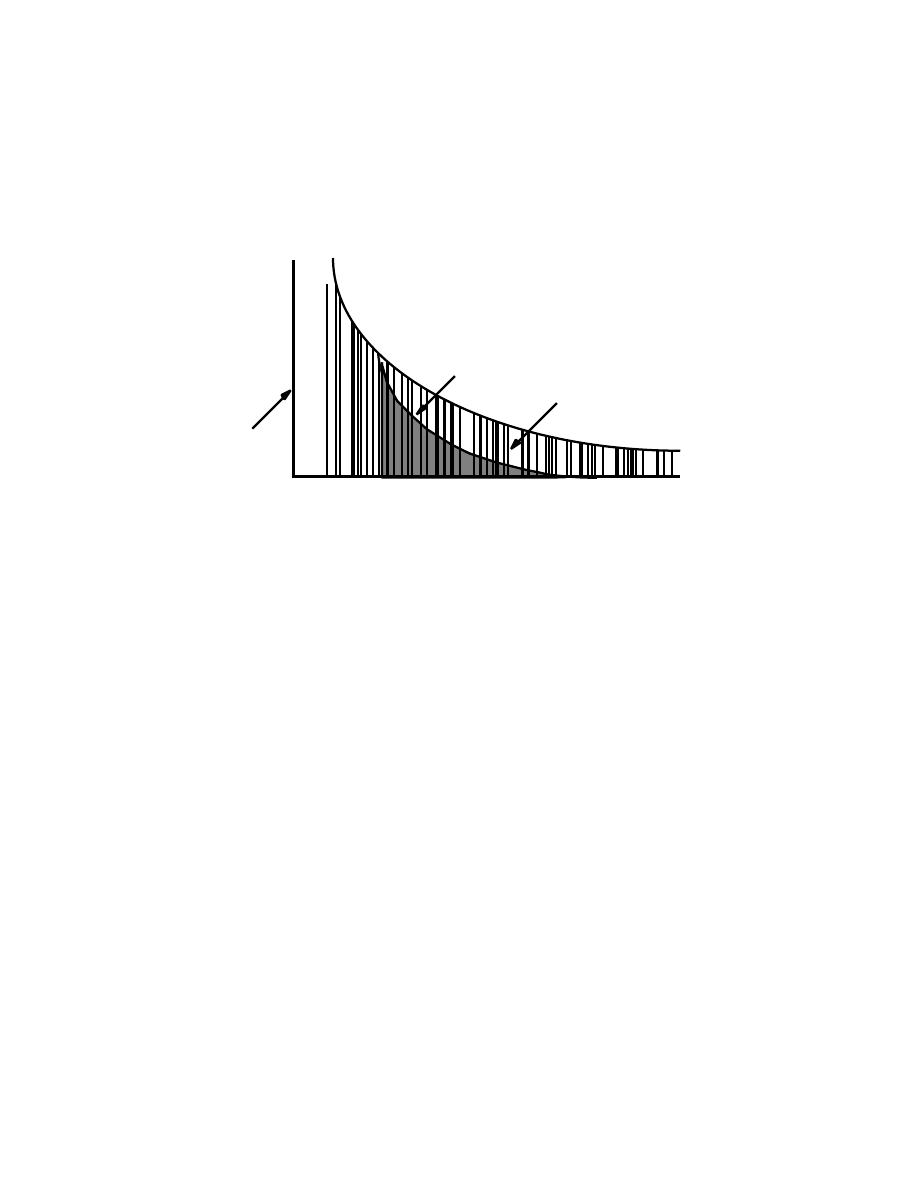ВУЗ: Казахская Национальная Академия Искусств им. Т. Жургенова
Категория: Учебное пособие
Дисциплина: Не указана
Добавлен: 03.02.2019
Просмотров: 12343
Скачиваний: 6

D
dynamic range: (1) The amplitude range of a sound from its softest to its loudest. (2) Also
called dynamic-range, the range of sound levels which a system can reproduce without dis-
tortion, i.e., the peak signal-to-average noise, or the difference between loudest level the
system can reproduce without distortion and the noise floor of the system. See Lmax/Lmin.
Bits
Levels
Theoretical best D.R./noise (dB)
Typical
(20 log 1 bit error/no. of bits)
Distortion
8
256
48.16
0.5%
12
4,096
72.25
0.1%
16
65,536
96.33
0.002%
24
16.772Mb
144.49
-
32
4.2949Gb
192.66
-
Desired dynamic range can be defined as the range of signal resolution plus the range of
amplitudes of the signals in the program material. For example, if there is a 12-bit signal
(72dB) and a range between Lmin and Lmax of 30db, the desired production dynamic range
would be 102dB.
In terms of recording, headroom plus the S/N ratio equals the dynamic range of the me-
dium. For acoustic spaces, the dynamic range is the range of SPLs between the acoustical
noise floor (about 30dB SPL for a quiet recording space) and the onset of nonlinearity in the
air (about 130dB SPL). This is about 100dB SPL, approximately the dynamic range of a
digital audio recorder, if you count all 16 bits as significant, which, of course, they’re not.
Dynamic Range
130 dB SPL
Onset of
distortion in air
Recording
Environment
Range: 90 dB
Acoustic Noise Floor: 40 dB SPL
120 dB SPL
Threshold
of Discomfort
Human Hearing
Range: 120 dB
0 dB SPL
Threshold
of hearing
20 dBV
Analog
Audio Signal
Range: 120 dB
Onset
of Clipping
-100 dBV
Headroom
~ 0 VU
0 dBV
Signal-to-
Noise Ratio
Electrical
Noise Floor
0 dBFS
~10 dBV
Digital (24-bit)
Theoretical
Audio Signal
Range: 144 dB
Clipping
-120 dBFS
Headroom
-12 to -14 dBFS
Electrical
Noise Floor
-144 dBFS
Numerical
Noise Floor

D
dynamic signal processor: Any electronic device whose type or degree of operation changes
with response to level or other characteristic of the input signal, i.e., with feedback, for exam-
ple compressors, downward and upward expanders, gates, limiters, NR systems, flangers, etc. The
opposite of static signal processing.
dynamic voice allocation: A feature of multitimbral synthesizers where a voice always is
made available to sound new notes when all the synth’s polyphonic voices are in use. In the
most common scheme, the most recently played note steals the voice from the oldest note
currently sounding, or sometimes the lowest amplitude sound. The usual alternative to dy-
namic allocation is to assign an inflexible, predetermined number of voices per sound. See
voice stealing.

E
early reflections (ER): (1) The first and following reflections from adjacent room bounda-
ries, as opposed to later reflections which are produced by farther surfaces or which have
taken a longer path to reach the listener. (2) A reverb algorithm whose output consists of a
number of closely spaced discrete echoes, designed to mimic the bouncing of sound off of
nearby walls in an acoustic space. See ESS, reflections, reverberation.
Impulse,
such as a
hand-clap
Amplitude
Time
Pre-
Delay
Early
Reflections
| |
|
Later, Dense
Reflections
Early Reflections
HF Decay
Mid-Range
and LF Decay
earwig: A small earpiece micropnone used to give actors an audio reference (frequently a
guide music track) so that their live audio can be recorded live. See also thumper, IEM.
ECC: Error Correction Code. See error correction.
echo: An audio effect which is a discrete (where the onset of the repeated sound is distinct)
repetition of a sound arriving at least 50ms after the incident sound, as opposed to reverbera-
tion, which is a continuous wash of closely spaced, non-discrete, echoing sound. See delay(3).
EDC: Error Detection Code. See error correction.
edge: A subjective impression of a certain roughness in the reproduced sound of a musical
instrument. It is usually caused by non-uniform, high-frequency response in the loud-
speaker or other audio device.
edgecode: Inked numbers applied outside the sprocket holes on file prints and mag film,
used for synchronization reference. See Acmade, preview codes.
edge track: (1) In multitrack recording, either of the recorded tracks located along the edge
of the tape. (2) The U.S. standard position of the recorded track on 16mm magnetic film, i.e.,
the position along the edge opposite the sprocket holes. See film soundtrack.
edit controller: See edit programmer.

E
edit decision list (EDL): Prior to editing a master recording or motion picture, the various
takes are auditioned and a list of the desired ones is created, along with notes telling exactly
where the cuts are to be made. The resulting document is the EDL. This consists of the list
of SMPTE timecodes--in feet/frames, including instructions for fades, dissolves, and other spe-
cial effects--corresponding to all the segments that the editor of a videotape production has
decided to use in the final cut. The EDL is usually computer-generated. See also playlist.
editing: Intercutting of several analog tape or digital data recordings of an audio or film
take in order to make an improved performance.
editing block: A cast metal block with a channel that holds magnetic tape firmly and in a
straight line. Diagonal slits through this channel allow a razor blade to make precisely an-
gled cuts in pieces of tape, so that two separate pieces aligned in the channel may be spliced
together. The resulting splice, if properly made, will be inaudible as it passes over the play-
back head of the recorder.
edit master: Video industry term for the tape containing the finished (edited) program.
edit mode: See cue mode.
editorial sync: Alignment of picture and soundtracks such that their start marks are equal
numbers of frames prior to the first frames of picture and sound, respectively. See projection
sync.
editor/librarian: A piece of computer software that allows the user to load and store patches
and banks of patches (the librarian) and edit patch parameters (the editor) by patch name.
edit programmer: A computer used to perform on-line edits and auto-assemblies. The
video editor enters the EDL, a sequence of SMPTE timecodes corresponding to the shots and
specific frames to be connected. The edit programmer then controls the video playback and
re-recording decks to produce the edited video master tape according to the editor’s instruc-
tions. Depending on the sophistication of the specific unit used, the editor may have to per-
form some special effects manually, on prompts given by the edit programmer. Also called
an edit controller.
edit switch: On a tape recorder, a switch that engages the play mode but not the take-up
motor. Tape is driven past the playback head and reproduced, but then spills off the ma-
chine and may be edited out. This process is called a dump edit. On some machines, the edit
switch merely defeats the tape lifters, allowing the editor to scrub the tape past the playback
head.
effect send level: The amount of effect to be added, such as reverb, chorusing, or other en-
hancements, to each channel.
effects: Abbreviated FX. Any form of audio signal processing or a device to produce: re-
verb, delay, chorusing, echo, flanging, and phasing, rotary (Leslie) speaker simulation, distortion,
and tremolo, etc. See processor.
effects bus: The mixing bus in a recording console used to mix the signal to be sent to the
various effects devices. Also called the effects send bus.

E
effects control: Two classes of Controller Change messages which are used to introduce and
adjust some kind of effect such as reverb.
effects control 1 & 2: Controller Change messages which are intended to be assignable to
parameters (other than depth) which appear in a synthesizer or effects unit and which con-
trol some aspect of an effect such as reverb time or pitch-shift. They operate in conjunction
with Effects Depth messages; the two message types taken together are called Effects Con-
trol.
effects depth: (1) A parameter on a synthesizer, effects unit, etc. which can be adjusted by
the user to alter the mount of a particular effect, such as reverb, delay, or chorus. (2) Effects
Depth controllers. Controller Change messages which are used to implement the function
described in Effects Depth. These were initially assigned to specific effects, but are now gen-
eralized and operate in conjunction with Effects Controls 1 & 2 messages; the two message
types taken together are called Effects Control.
effects loop: A mixing console circuit that is used to add an effect to a signal or a group of
signals. When the effect unit is plugged into the effects bus circuit (via the effects send and ef-
fects return jacks), it literally functions as a loop, splitting the signal off from the mixer and
sending it to the effect, then returning it to the mixer, where it is combined with the original
signal.
effects master: See effects send.
effects return: An input on a mixing console that receives the wet signal from the effects de-
vices. The effects return inputs usually have volume controls (faders) to control the intensity
of the particular effect in use.
effects send: An output from a mixer that is connected to the input of an effects device. The
effects send outputs usually have volume controls to set the effect send level, and the overall
level of all the effects send outputs may be controlled by an effects master control operating
from the effects bus. Effects sends (usually referred to in this case as aux sends) are typically
used to feed effects processors such as reverbs, or are used to feed monitor systems, either
speakers on stage or headphones in the studio. Whereas the main outputs of a mixer have a
mix of everything that has a main fader turned up, the effects sends, with their own mix
controls, have an independent mix. Effects sends are also used to feed the house mix to the
PA system, when they are usually called post-fader sends. Also called an aux (auxiliary) send.
See insert send.
effects track: (1) An edited track of magnetic film containing sounds other than dialog or
music. There can be many effects prepared for a film mix. (2) In videotape productions
whose sound is assembled on a multitrack tape, the track or tracks on which sound effects
are recorded. (3) In the 35mm three-track mix of a motion picture, the recorded track that
contains sounds mixed from all the effects tracks. See film soundtrack.
efficiency: A measure, usually applied to loudspeakers, of how much of the input electrical
energy is converted to sound energy, expressed in percent. The remaining energy is con-
verted into heat.